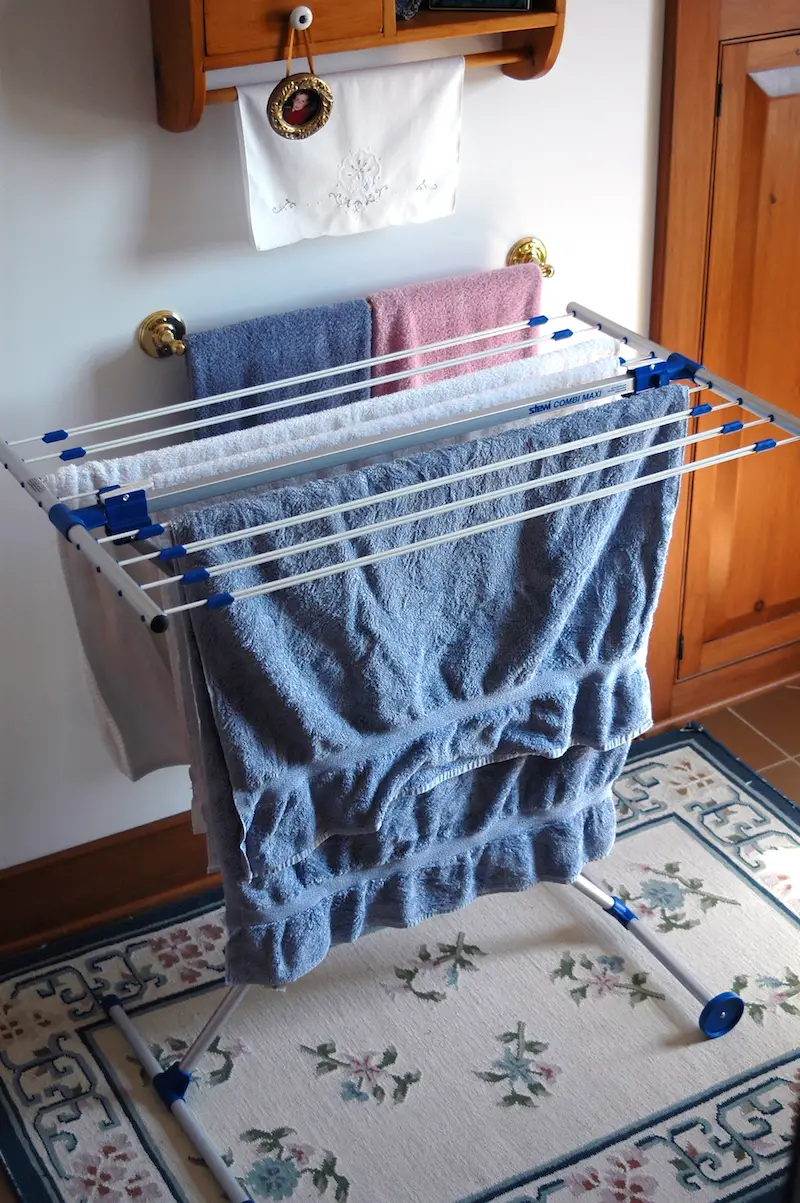You can tell a lot about a society by the quality of indoor clothes drying racks it offers for sale. When you’ve got a population seriously committed to household conservation and energy efficiency, you’ll find excellent drying racks in stores everywhere. But when you’ve got a society that’s largely ignorant of the hidden costs of running every wet article of clothing through a power-gobbling dryer, you’ll find stores littered with $49.98 drying racks that bend, break and collapse. Sadly, over the last four or five decades, Canada, the country where I live, has become a cheap-drying-rack-kind-of-place, though I think this is beginning to change. The internet is the reason why.
- Reading time = 4 minutes

Power Gobbling Dryers
No other domestic appliance in your home uses more electricity per hour of operation than a dryer. You can run a 40-watt incandescent light bulb for more than 130 hours on the electricity consumed during just one 45-minute dryer cycle. Over-consumption of electricity is not only financially expensive for each of us as individuals, but it also has to be generated somehow. Electricity is great, but the more economical our energy use, the better.
High Quality Drying Racks
If availability of high quality drying racks is any indication, perhaps our homegrown addiction to dryer over-use may finally be over. One reason I’m hopeful is the Swiss-made drying racks that have been quietly refined and perfected in the land of the Alps for the last 75+ years. They’re impressive, effective and promise to bring a whole new level of legitimacy to the practice of indoor clothes drying. The brand we’ve been using for decades at my house is called Stewis, and you’ll find these drying racks in hotels, homes and institutions all across Europe. Click here for the website. You’ll find retailers in different countries around the world.
Stewis offer some of the best drying racks in the world, and when you properly consider what they deliver, the prices are surprisingly good, too.All this is great news to me, because over the years I’ve been searching in vain for good clothes drying racks. And I’ve come up short many times.
Observant visitors to my house years ago would no-doubt have noticed two decrepit indoor clothes-drying racks bandaged with every conceivable method of repair. Broken rungs have been welded, tie-wrapped, taped and replaced with pieces of 5/16-inch dowel. The way I figure it, what’s the point in buying a new piece of junk for $50 (destined to break in a week anyway) when I can fix the old junk for free?
Thankfully, our junk racks have long been recycled by now, replaced with a couple of cool Stewis that make me feel great just looking at them. We certainly use our outdoor clothesline whenever weather permits, but when it’s cold and wet outside, these indoor racks take up the slack quite nicely.
Durability
The model we use for bathroom towels is similar in shape to the scissor-legged basket-case we tolerated for years, except that the Swiss model is:
- Infinitely stronger
- Rack area expands and contracts in length, depending on how much hanging room you need.
- Our particular design is called the Combi Maxi
- The biggest difference between our old rack and this one is the design of the hanging rungs themselves. Instead of flimsy, breakage-prone, spot-welded steel rods, the Combi Maxi uses rigid, corrosion-proof rungs anchored directly into tubular aluminum cross members.
- One quick look and you’ve got to ask yourself if there’s anything that the Swiss don’t take seriously.
Design
It’s not just durability that continues to impress me about the Stewis line, it’s also design:
- The company offers elegant, space-saving, ceiling-mounted racks.
- My favourite is called the Lift.
- Simply release a cord and the drying frame drops down about 3 1/2 feet.
- Clip your wet clothes on the rack, then pull the cord again and the whole thing rises to ceiling height, keeping the floor area clear.
When I think about how a good drying rack makes it so much easier to minimize dryer use, I’m reminded that many of our environmentally expensive habits would be easier to kick if we just had elegant, frugal (and preferably cool) alternatives. And while indoor drying racks aren’t going to completely reconfigure our electrical system, isn’t it still true that every little bit helps?
 Was this article useful? I hope so. Please consider helping me cover the cost of creating and publishing content like this. Click the “buy me a coffee” button below for a safe, simple and fast way to make a contribution. Thank you very much!
Was this article useful? I hope so. Please consider helping me cover the cost of creating and publishing content like this. Click the “buy me a coffee” button below for a safe, simple and fast way to make a contribution. Thank you very much!
– Steve Maxwell


